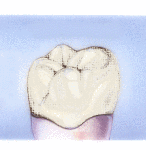Below we explain the procedure for Crowning (Capping) a tooth. This procedure is performed when a tooth has so much structure missing, either due to decay or breakage, that the tooth cannot hold a filling.
The front half of this lower right first molar has broken, and cannot be reliably restored with a filling. A crown is indicated here.
First, after the patient is "comfortably numb", the tooth is prepared for a crown. To do this, the tooth is shaped around the entire circumference, as well as the chewing surface.
Crown Fun Fact #1
The goal of shaping a tooth for a crown is to reduce the tooth by the same thickness that the future crown will be. Example: If the crown will be 2 mm (millimeters) thick, we reduce the tooth by 2 mm.This results in the crown being the same size as the original tooth. Very natural looking and desirable.
An impression is made of the shaped tooth. Apparently, here we're using some kind of cloudy blue stuff, but in reality it will be a putty-like material contained in a small tray to make it easy for you.
Crown Fun Fact #2
If the tooth is not reduced enough, then the crown, which has to be a given thickness, will add bulk to the tooth. The final result may be a rounded, "chicklet"-like shape that is not too esthetically desirable. I'm sure you've seen these out there in people's mouths, and were nice enough not to comment about it.
The impression goes to go to the dental laboratory for fabrication of the crown. It takes about a week. Patients don't seem to be too happy about going home without a tooth, so we make a temporary crown on the spot, made of acrylic and kept in place with a temporary cement. It should look, feel, and function pretty much like a normal tooth so there should be at most, only a minimal impact on your lifestyle.
The permanent crown comes back from the laboratory. It is checked to ensure that it has proper fit, esthetic appearance, and function. I usually will use a temporary cement here, and let the patient try it in place for a week, to make sure that it works well too.
"You have to test drive it before you buy it!"
Crown Fun Fact #3
There should be a minimal "break in period" with a new crown if we're simply replacing a broken tooth. When it is first put into your mouth it should feel "like it's always been there". There are exceptions, but not a lot of them.
About a week or so later, you return. If the crown feel great, we pop it off and put it back on with a permanent cement. It should function like a healthy tooth, so there should be no restrictions with eating. Just try to avoid getting into bar fights! (lol)
Examples of an upper front tooth crown, and a lower back tooth crown. The front tooth is shown how it looks in cross-section, with the tooth shaped beneath it.
Crown Fun Fact #4
Crowns can be made of several different materials. Porcelain crowns are esthetically better and can be used in front teeth, but they are more fragile and subject to fracture than Porcelain Fused to Gold Crowns, which tend to hold up better on back teeth.
IMPORTANT NOTE
In dental procedures, like all other medical procedures, every situation is different and there may be limitations and restrictions as to what can be done, and what results may be achieved, so there are no guarantees here.
This is where faith and trust in your doctor come in.
"We don't have the Owners Manual for the Human Body"
(516) 822-2911
559 Woodbury Road
Plainview, NY 11803






